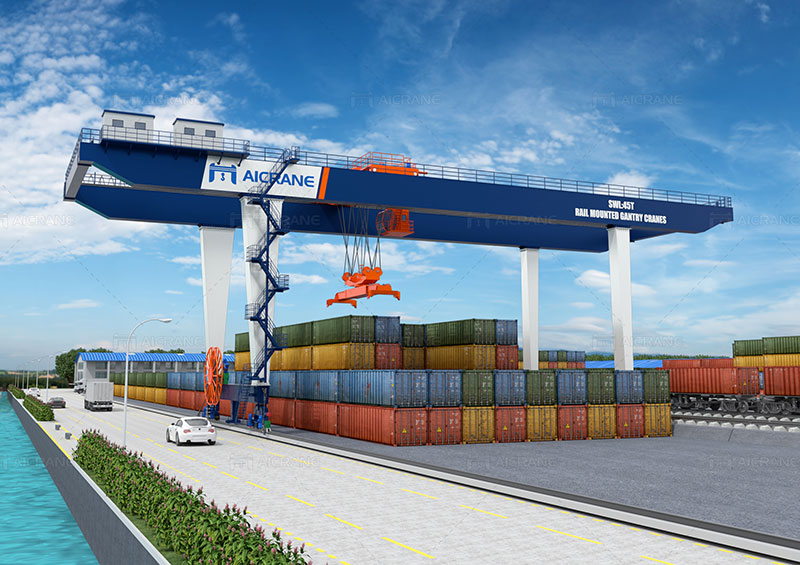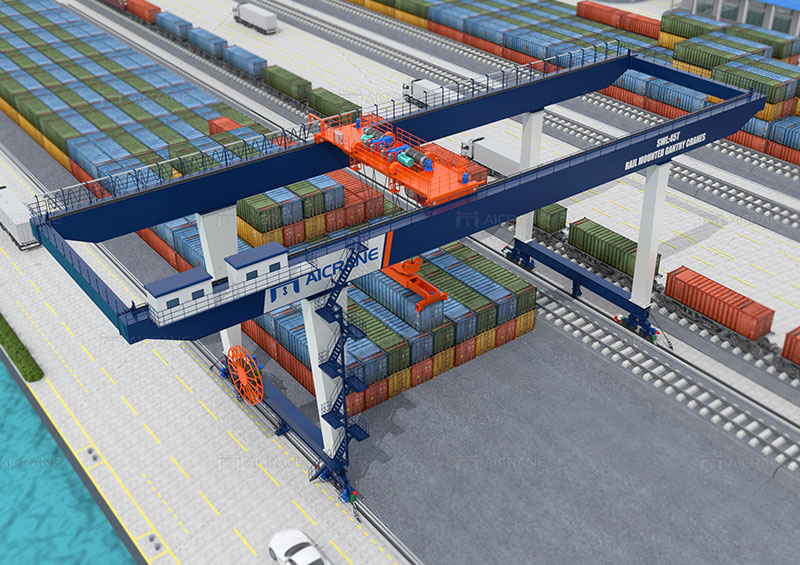Container cranes play a vital role in modern port operations, enabling the efficient and safe handling of containers between ships, docks, and storage areas. These cranes are the backbone of global trade, as they facilitate the rapid movement of goods in and out of ships, reducing turnaround times and boosting port productivity. Over the years, container cranes have evolved to handle larger vessels, heavier cargo, and more complex tasks. In this article, we will explore the different types of container cranes, their features, and their applications, providing an overview of the basics of container crane types.

1. Ship-to-Shore (STS) Cranes
Ship-to-shore cranes, also known as port cranes or dockside cranes, are the most iconic type of container crane. They are typically used for loading and unloading containers from ships docked at the port. These cranes are large and robust, designed to handle the massive weight and size of containers.
Key Features:
- Boom and Jib Design: STS cranes have a long horizontal arm (boom) that can extend over the side of a vessel. The boom is mounted on a tower-like structure called the “trolley,” which allows the crane to move horizontally along the quay.
- Capacity: They are designed to lift containers of varying weights, from standard 20-foot containers to larger 40-foot and 45-foot containers.
- Reach: Some of the most modern STS cranes can extend their boom to reach over the largest vessels, such as Post-Panamax and Super Post-Panamax ships.
- Speed: STS cranes are known for their speed and precision, capable of loading and unloading multiple containers per hour.
Applications:
- Port Operations: The primary application of STS cranes is in port terminals, where they are used to transfer containers from ships to the shore and vice versa.
- Handling Large Ships: These cranes are essential for handling large container vessels with a high capacity, such as those over 12,000 TEU (Twenty-foot Equivalent Unit).
2. Rail-Mounted Gantry (RMG) Cranes
Rail-mounted gantry cranes (RMGs) are used in container yards and terminals for the horizontal transportation of containers. These cranes are mounted on tracks, allowing them to move along a fixed path. They are typically employed in container storage yards, where they load and unload containers from trucks, trains, and other transport vehicles.

Key Features:
- Fixed Rails: Rail mounted gantry cranes run on tracks that are typically laid out parallel to the container stacking area. They can move along these rails, stacking containers in neat rows and accessing them for loading or unloading.
- Capacity: RMG cranes are capable of handling a wide range of container sizes and weights, depending on the design. They are typically used in container yards where large quantities of containers need to be moved efficiently.
- Flexibility: While their movement is limited to tracks, RMGs offer great flexibility within that space, allowing them to lift, stack, and move containers between different rows.
Applications:
- Container Yard Operations: RMG cranes are primarily used in container yards, facilitating the movement of containers between storage areas and transportation vehicles (trucks, trains, etc.).
- Port Terminals: In large ports, RMG cranes are often used in combination with STS cranes to streamline the loading and unloading process.
3. Rubber-Tyred Gantry (RTG) Cranes
Rubber-tyred gantry cranes (RTGs) are similar to RMG cranes in terms of functionality but differ in their mobility. Unlike rail-mounted cranes, RTGs are mounted on wheels, making them highly mobile and flexible in their movement.
Key Features:
- Mobility: Rubber tired gantry cranes are equipped with rubber tyres, which allow them to move freely across the yard without being confined to a rail system.
- Capacity: They typically have a lifting capacity ranging from 40 to 50 tons, with some models capable of handling even heavier loads.
- Stacking Ability: RTGs are often used for container stacking and retrieval, enabling operators to store containers up to five or six layers high.
- Electric or Diesel Power: RTGs can be powered by electricity or diesel engines, with electric-powered RTGs being increasingly popular due to their lower emissions and operating costs.
Applications:
- Flexible Port Operations: RTGs are commonly used in ports with limited space or in areas where container movement must be more flexible.
- Container Yard Management: They are ideal for handling containers in confined spaces, making them suitable for smaller or more dynamic container yards.
4. Straddle Carrier Cranes
Straddle carrier cranes are another type of mobile container crane that is often used in container yards. These cranes are equipped with four wheels and can “straddle” a container, lifting it and moving it to a different location within the yard.
Key Features:
- Mobility and Versatility: Straddle carriers can easily move around the yard, allowing operators to transport containers across various sections.
- Lifting Capacity: Typically, these cranes can handle containers weighing up to 40 tons.
- Speed: Straddle carriers can operate at relatively high speeds, helping reduce turnaround time in container yards.
Applications:
- Container Transport: Straddle carriers are used to transport containers across port yards and storage areas.
- Port and Inland Terminals: These cranes are used in both seaports and inland container terminals, making them versatile for various container handling tasks.
5. Mobile Harbour Cranes
Mobile harbour cranes are versatile, self-propelled cranes that can be used for a variety of cargo handling operations, including container handling. They can operate on ships, barges, and at quay-side terminals, offering greater flexibility compared to fixed cranes.
Key Features:
- Portability: Mobile harbour cranes are mounted on wheels or tracks, making them portable and easy to move between different locations.
- Capacity: They have a high lifting capacity and can handle large, heavy containers and other types of cargo.
- Flexibility: These cranes are adaptable for different container sizes and operational environments, including tight spaces and rough terrain.
Applications:
- Port Terminals: Used for loading and unloading containers at ports where space or time constraints require a flexible solution.
- Barge and Vessel Operations: Mobile harbour cranes can also be used to handle containers on barges or vessels.
6. Automated Container Cranes
With the rise of automation in the logistics industry, automated container cranes (ACC) are becoming increasingly common. These cranes use advanced technologies like sensors, robotics, and artificial intelligence to operate without direct human intervention.
Key Features:
- Automation: Automated cranes use sensors and software to perform tasks such as loading, unloading, and stacking containers.
- Efficiency: These cranes can operate continuously, 24/7, with high precision and minimal downtime.
- Cost-Effective: Although they require a significant initial investment, automated cranes can reduce labor costs and increase overall terminal productivity.
Applications:
- Fully Automated Ports: Automated cranes are mainly used in ports where operations are entirely or mostly automated, reducing the need for manual labor.
- High-Volume Terminals: These cranes are ideal for terminals with high volumes of container traffic that require precise and rapid operations.
Conclusion
Container cranes are an essential part of modern port operations, offering a wide variety of types and designs to meet the ever-growing demands of global trade. Whether it’s the towering Ship-to-Shore cranes handling massive vessels, the mobile flexibility of Rubber-Tyred Gantry cranes, or the increasing trend towards automated cranes, each type of container crane plays a crucial role in ensuring the efficient flow of goods across the globe. Choosing the right crane for specific needs, whether in terms of capacity, mobility, or automation, is key to improving the overall efficiency and competitiveness of a port.